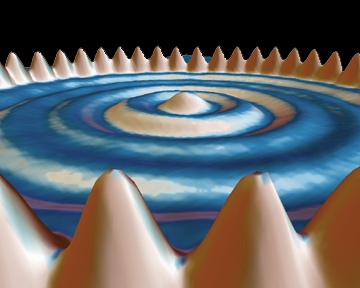
Dubbed a "quantum corral" by its creators, this is a ring of 48 iron atoms on a copper surface. The iron atoms confine some of the copper's electrons, forcing them into quantum states visible as circular rings inside the corral.
The 48 iron atoms, adsorbed onto the copper surface, were moved into position with the tip of a scanning tunneling microscope, to make a ring with a radius of 71.3 Ångstroms. This created a barrier that forced surface state electrons into quantum states seen here as circular rings of electron density in the ring's interior. Colors are added artificially. Scanning tunneling microscopes, invented in 1981, allow direct imaging of individual atoms by scanning a metal tip across a surface to pick up free electrons that "tunnel" into the tip, producing a current. The same tip can be used to move atoms and molecules on the surface.
Image by Don M. Eigler
See: M.F. Crommie, C.P. Lutz, D.M. Eigler. Confinement of electrons to quantum corrals on a metal surface. Science 262, 218-220 (1993).

